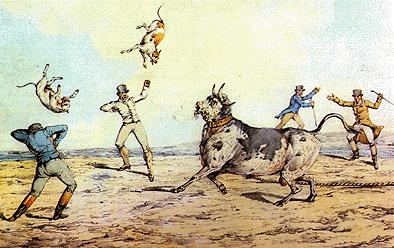
Pit Bull Terriers: a `Darwinian Nightmare' ?
It has come as a shock to many people in the UK that there are thousands
of individuals who want to own a fighting dog. Furthermore, it is now clear
that some breeders have spent years trying to develop animals with powerful
vice-like jaw muscles, a larger head, superior blood clotting ability, great
agility and an exceptional eagerness to fight. The story started in the
early part of the 19th Century, when the Bulldog was bred in England for
the purpose of bull baiting.

"Tenderising" the meat on a tethered bull, prior to slaughter
and sale.
Parliament banned bull baiting in 1835, responding to the public outcry.
The Bulldog was cross bred with the Terrier to produce the Staffordshire Bull Terrier, and it is this breed that was used to produce the American Staffordshire and American Pit Bull Terriers.
Just as the fictional Baron Frankenstein found that his created masterpiece became a monster too hot to handle, so the Pit Bull Terrier breeders are said to have produced an unpredictable killer dog. Instead of being `man's best friend', this dog is such an inveterate fighter that some say it cannot be trusted to do anything but rush into a savage attack. According to one RSPCA inspector, quoted in The Independent (21 May 1991, page 3), "They're bred to kill. No other dog is like them". It was this same inspector who described them as "a Darwinian nightmare".
Great divergencies of view are to be found among the general public. Some folk are demanding that the breed be exterminated, others insist that actions should be directed against the owners and breeders, rather than against the dogs, and others (mainly owners) point out that the dogs have an unmatched affection for people! It is not the purpose of this article to take sides on this issue, but to comment on a common misunderstanding of observed variations in living things.
Despite our knowledge of genetics, many people still think that selective breeding programmes are examples of evolutionary processes in action. This belief originates, of course, from Charles Darwin himself. In The Origin of Species, he included examples of variations in domestic dogs in a chapter on the influence of human selection on animals and plants. Darwin wrote: `Over all these causes of change, the accumulative action of selection, whether applied methodically and quickly, or unconsciously and slowly but more efficiently, seems to have been the predominant power'. The idea conveyed is that selection, whether natural or directed, is the driving force for evolutionary change, acting on naturally-occurring variations. A `Darwinian nightmare' would suggest that the driving force is so guided by human breeders that the organism is `moulded' into a monster which turns against its creator.
The problem with this popular view is that it is almost completely false! The science of genetics destroyed this type of argument nearly 100 years ago! The variability which is manipulated by selective breeding exists already within the organism. There is no scientific basis for saying that living things can be moulded without limits by selective forces. In the Introduction to Dent's 1956 edition of The Origin of Species, Professor W.R. Thompson wrote:
-
`But the facts and interpretations on which Darwin relied have now ceased
to convince. The long-continued investigations on heredity and variation
have undermined the Darwinian position.'
Creationists have pointed out real problems with the proposed genetic mechanisms for introducing new variability. We have shown, for example, that they are generally harmful to organisms and that they are incapable of introducing meaningful new information to the genetic code. More positively, we have sought to develop the concept of the `created kind'. According to The Bible (Genesis chapter 1), organisms were created distinct from one another and were commanded by God to `reproduce after their kind'. Adam and Eve were the original parents of `man-kind'and all modern representatives of the human race are related by descent. Yet we know that a great diversity of characteristics exists: skin pigmentation, hair colour and texture, the shape of head and facial features, the size of skull, height of body, and so on. All this diversity was programmed into the created genetic code given to our first parents. We should not be surprised when we find a similar potential for variation among animals and plants. Indeed, observations like this should stimulate within us a spirit of worship of the Creator, whose works continually reveal the richness of His wisdom and power.
We know that all domestic dogs are related, and that interbreeding is possible with wolves, jackals, coyotes and dingoes. Creationists have suggested that all these groups of species belong to a single created kind. We also recognise that, in the case of domestic dogs, some of the breeds carry mutant genes and exhibit characteristics which go beyond the limits of created variability.
The main difficulty in assessing the threat posed by Pit Bulls is in interpreting their particular behavioural traits. The relationship between genes and behaviour is not understood, although it is clear that there is no simple correspondence. Genetics has focused attention on the visible characters of organisms but we should not neglect the less tangible subject of animal behaviour. What a different world it would be if animals all had the same instincts! God's handiwork is no less seen in animal behaviour than in genetics, but we have to acknowledge that the subject is largely a mystery. It appears that a complex mix of instincts are passed on to an animal by its parents, and also that certain behavioural patterns can be reinforced or modified as it grows up. This latter point is sufficient to insist that owners be held accountable for the behaviour of their dogs. Though we do not subscribe to the `Darwinian nightmare' scenario, we do suggest that sinful man is particularly adept at spoiling the beauty of God's creation, and at exploiting, rather than ruling (Genesis chapter 1, verse 20), the animals that God has entrusted to his care. By a life of obedience to God's command, we can demonstrate to the world around us that there is a better way.
David J. Tyler (1991, revised 1998)

